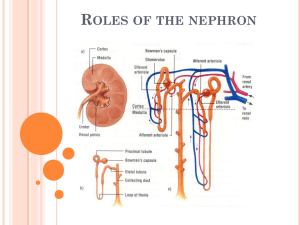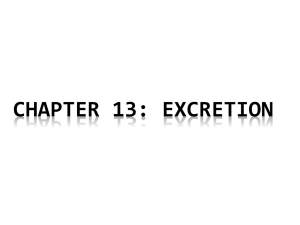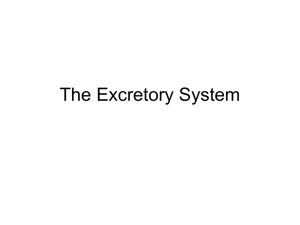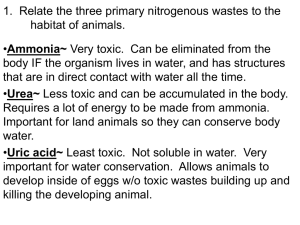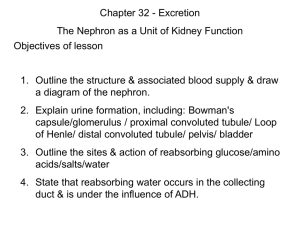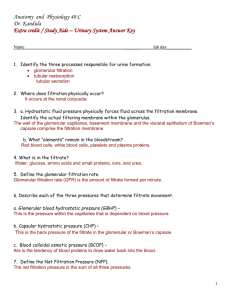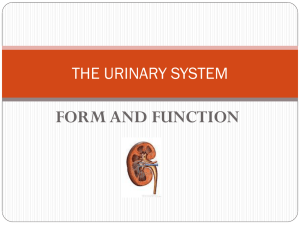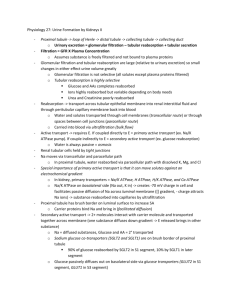Excretory ppt
advertisement
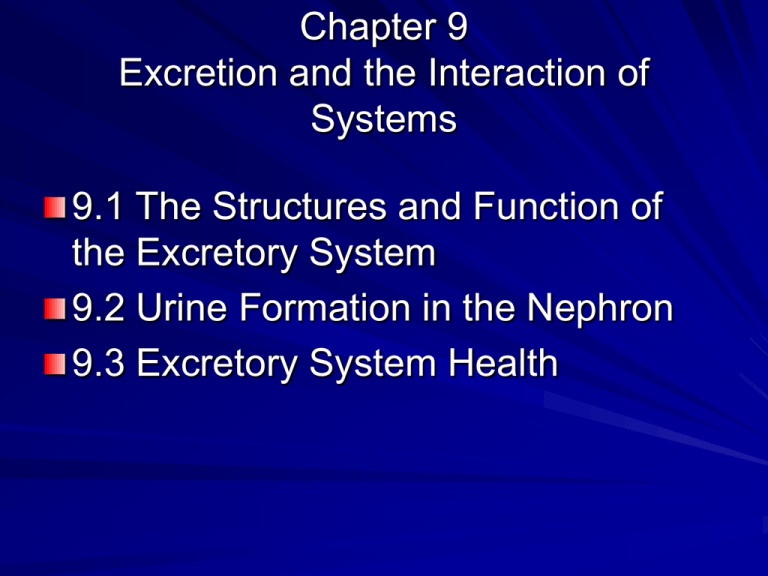
Chapter 9 Excretion and the Interaction of Systems 9.1 The Structures and Function of the Excretory System 9.2 Urine Formation in the Nephron 9.3 Excretory System Health Chapter 9 Excretion and the Interaction of Systems In this chapter, you will learn: Each kidney receives blood that is processed to form urine, which drains through a ureter and into the urinary bladder for excretion. Each kidney contains over one million nephrons that process blood to form urine. The functional unit of the kidney is the nephron. Each nephron filters blood, reabsorbs substances such as sodium and glucose for reuse in the body, and secretes excess or toxic substances such as urea to produce urine. Antidiuretic hormone (ADH) regulates the amount of water reabsorbed in the distal tubule. Aldosterone regulates the amount of salt that is reabsorbed or secreted. The acid-base balance of the blood is adjusted by the secretion of hydrogen ions and reabsorption of bicarbonate ions. Various technologies are used to solve problems involving dysfunctions and disorders of the excretory system. 9.1 The Structures and Function of the Excretory System In this section, you will: identify the main structures and functions of the human excretory system explain the function of the nephron Organs of the Excretory System Kidneys The view in (A) includes some blood vessels to reinforce the connection between the circulatory and excretory systems. The views in (B) and (C) do not include blood vessels, and identify the three regions of the kidney: renal cortex, renal medulla, and renal pelvis. The view in (C) introduces the functional unit of the kidney: the nephron. Excretion excretion involves the removal of ingested materials or metabolic wastes Note: versus elimination from the digestive system which differs by removing foodstuffs that are unused/unabsorbed excretion is performed by: – the skin – waste heat, urea, water, salts – the respiratory system – CO2(g), water, alcohol, garlic – the kidneys – urea, uric acid, excess water, salts (through the urine) The Urinary System is responsible for maintaining the concentration of solutes in the blood, pH and blood volume consists of the kidneys, ureters, bladder and urethra the urethra is about 3.8 cm long in women, and 20 cm long in men – women are at a much greater risk for urinary tract infections due to the shortness of the urethra – bacteria have a much shorter distance to travel to reach the security of the bladder the functional unit of the kidney is the nephron, which filters the blood and collects urine for excretion The Nephron if the nephrons of an adult were stretched out end to end, they would measure 80 km! 180L of blood is filtered daily by the kidneys the kidneys produce on average 1mL of urine every minute the nephrons perform three duties – filtration: which occurs in the Bowman’s capsule – selective reabsorption occur throughout the nephron – selective secretion Nephron Functional Regions of the Nephron p.308 1. A Filter: – The filtration structure at the top of each nephron is a cap-like formation called the Bowman’s capsule. – Within each capsule, a renal artery enters and splits into a fine network of capillaries called a glomerulus. – The walls of the glomerulus act as a filtration device. They are impermeable to proteins, other large molecules, and red blood cells, so these remain within the blood. Functional Regions of the Nephron p.308 – Water, small molecules, ions, and urea—the main waste products of metabolism—pass through the walls and proceed further into the nephron. – The filtered fluid that proceeds from the glomerulus into the Bowman’s capsule of the nephron is referred to as filtrate. 2. A Tubule: – The Bowman’s capsule is connected to a small, long, narrow tubule that is twisted back on itself to form a loop. – This long, hairpin loop is a reabsorption device. – The tubule has three sections: the proximal tubule, the loop of Henle, and the distal tubule. – Like the small intestine, this tubule absorbs substances that are useful to the body, such as glucose and a variety of ions, from the filtrate passing through it. – Unlike the small intestine, this tubule also secretes substances into the tissues surrounding it. 3. A Duct: – The tubule empties into a larger pipe-like channel called a collecting duct. – The collecting duct functions as a waterconservation device, reclaiming water from the filtrate passing through it so that very little precious water is lost from the body. – The filtrate that remains in the collecting duct is a suspension of water and various solutes and particles. It is now called urine. – Its composition is distinctly different from the fluid that entered the Bowman’s capsule. – The solutes and water reclaimed during reabsorption are returned to the body via the renal veins. 9.2 Urine Formation in the Nephron In this section, you will: explain the function of the nephron in maintaining the composition of blood plasma describe the function of the kidney in excreting metabolic wastes and expelling them into the environment Urine Formation Creating Urine: (remember that the contents of the nephron is what is deposited in the collecting duct and is excreted as urine – reabsorption means back into the blood, secretion means into the urine) Filtration (occurs in Bowman’s capsule) – as the blood enters the nephron at the glomerulus ( a cluster of blood vessels) it is at 2x the pressure than in other parts of the body – this higher BP forces 20% of the non-protein protion of the plasma into Bowman’s capsule (the beginning of the nephron) – nonselective filtration – the filtrate (what enters the nephron) contains water, glucose, salts, vitamins and urea (in the same concentrations as in the plasma) Selective Reabsorption and Secretion (occurs throughout the remainder of the nephron) 1. proximal convoluted tubule (about 65% of filtrate is reabsorbed here) Na+, K+, amino acids and glucose are reabsorbed into the blood by active transport water follows by osmosis H+(aq) is secreted (by the blood) by active transport to maintain pH drugs and poisons processed by the liver are secreted into the tubule Reabsorption in the Proximal Tubule 2. Descending loop of Henle water continues to be reabsorbed by osmosis (due to osmotic gradient) this part of the loop is only slightly permeable to ions the filtrate becomes more concentrated as water is reabsorbed 3. Ascending loop of Henle Na+ ions are passively (firstly – thin part) then actively reabsorbed (the tubule is now permeable) this part of the loop is impermeable to water the filtrate becomes less concentrated as the salts are reabsorbed, but water is not Reabsorption in the Loop of Henle 4. Distal convoluted tubule K+(aq), H+(aq) are secreted by the body to maintain homeostasis HCO3-(aq), Na+(aq) are reabsorbed by the body to maintain homeostasis water is reabsorbed by osmosis 5. Collecting duct Water is reabsorbed by osmosis Reabsorption in the Distal Tubule and Collecting Duct Parts of the Nephron and Their Functions Glomerulus Filtration • Glomerular blood pressure forces some of the water and dissolved substances from the blood plasma through the pores of the glomerular walls Bowman’s capsule Receives filtrate from glomerulus Proximal tubule Reabsorption • Active reabsorption of all nutrients, including glucose and amino acids • Active reabsorption of positively charged ions such as sodium, potassium, calcium • Passive reabsorption of water by osmosis • Passive reabsorption of negatively charged ions such as chloride and bicarbonate by electrical attraction to positively charged ions Secretion • Active secretion of hydrogen ions Descending loop of Henle Reabsorption • Passive reabsorption of water by osmosis Ascending loop of Henle Reabsorption • Active reabsorption of sodium ions • Passive reabsorption of chloride and potassium ions Distal tube Reabsorption • Active reabsorption of sodium ions • Passive reabsorption of water by osmosis • Passive reabsorption of negatively charged ions such as chloride and bicarbonate Secretion • Active secretion of hydrogen ions • Passive secretion of potassium ions by electrical attraction to chloride ions Collecting tube Reabsorption • Passive reabsorption of water by osmosis 9.3 Excretory System Health In this section, you will: describe how the kidneys contribute to homeostasis with respect to water and ions relate the design of dialysis technologies to the design of the kidney Regulation of Reabsorption and Secretion Reabsorption and Secretion are regulated by the endocrine system (via hormones) in response to: – Changes in blood pressure – Changes in solute concentration in the blood Regulation of Reabsorption and Secretion 1. Aldosterone is secreted in response to a decrease in blood pressure the BP stimulates aldosterone release from the adrenal glands (located on top of the kidney) aldosterone leads to Na+ reabsorption, which leads to H2O(l) reabsorption (by osmosis), which blood volume, and therefore blood pressure (if the diameter of the vessels remains constant) 2. ADH (anti-diuretic hormone or vasopressin) secretion will if the concentration of solutes in the blood becomes too high [solute] leads to ADH (made by the hypothalamus in the brain but stored in the pituitary gland) ADH leads to permeability of the distal convoluted tubule to H2O(l) H2O(l) reabsorption [solute] in the blood (just for interest, diabetes insipidus is caused by damage to the hypothalamus which results in NO ADH secretion – those affected produce up to 30L (that is almost two big water cooler bottles) of urine per day – ADH is a very powerful hormone – it was incorrectly called diabetes because one of the symptoms of diabetes mellitus is that those affected produce large amounts of urine) The release of ADH controls the amount of water reabsorbed or excreted in urine. Kidney Stones Hemodialysis & Peritoneal Dialysis Chapter 8 Review Draw a diagram or flowchart to show how the excretory system works. What wastes are produced by the human body? Describe the functions of each major structure in the excretory system. How does the excretory system interact with blood and circulation? Why do wastes need to be eliminated from the body? Concept Organizer Chapter 9 Summary The metabolic activities of cells, including energy release, maintenance, and repair, produce substances that change the balance of the volume of water and the concentration and composition of dissolved substances in the body’s fluids. The excretory system removes these materials to maintain the optimal volume of water and composition of body fluids, dispose of wastes, and recycle the non-waste substances. The substances in question include carbon dioxide; water; ions of sodium (Na+), chloride (Cl–), and hydrogen (H+); and other compounds resulting from the breakdown of proteins and nucleic acids. The excretory system also plays a key role in maintaining the acid-base balance (pH) in the blood. The organs of the excretory system are the kidneys, the ureters, the urinary bladder, and the urethra. The kidneys contain millions of tiny nephrons that each contain a filter, a tube, and a duct. The nephrons filter out waste and reabsorb substances such as sodium and water for reuse by the body’s systems. The resulting filtrate, known as urine, is sent through the ureters to the urinary bladder for temporary storage until it is eliminated from the body through the urethra. Disorders of the excretory system include urinary tract infections, kidney stones, and renal insufficiency. Renal insufficiency may require dialysis or a kidney transplant in order to ensure that wastes are secreted rather than building up to toxic levels in the body.

